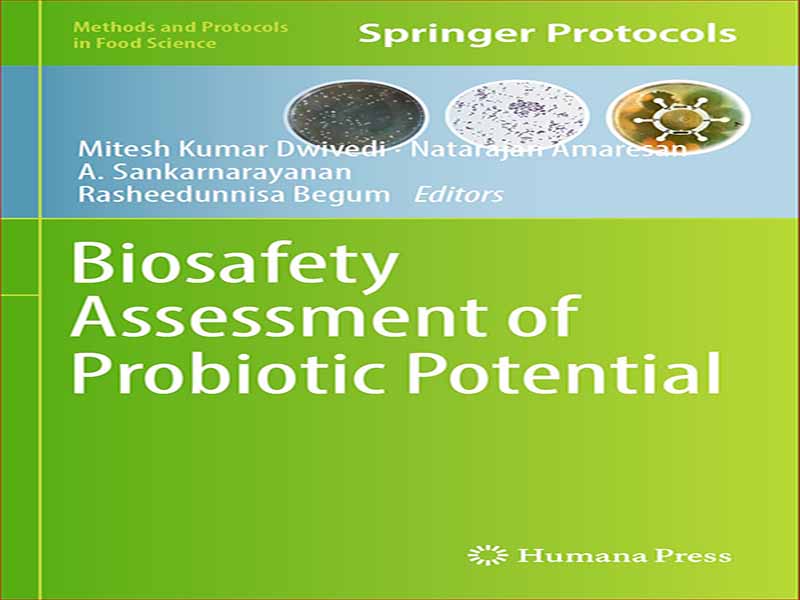روند رو به افزایشی در استفاده از پروبیوتیک ها به عنوان مکمل های غذایی و مواد غذایی که باعث ارتقای سلامت و مبارزه با بیماری های مختلف در سراسر جهان می شوند وجود دارد. محققان ایده های نوآورانه ای را بر روی تحقیقات مبتنی بر پروبیوتیک ریخته و فواید آنها را برای بشریت گزارش می کنند. پروبیوتیک ها با کاربردهای متنوع خود به عنوان تعدیل کننده های ایمنی، عوامل آنتی اکسیدانی و عوامل ضد سرطان زا، بال های خود را گسترش می دهند و توانایی جذب مواد مغذی میزبان را افزایش می دهند و به عنوان یک بیماری برای بیماری های مختلف. اگرچه ارگانیسمهای پروبیوتیک سابقه وسیعی در استفاده ایمن دارند، با این حال، بررسیها و گزارشهای تحقیقاتی اخیر نگرانیهای نگرانکنندهای را در مورد مسائل ایمنی استفاده از پروبیوتیک ایجاد کردهاند. به طور خلاصه، اثرات نامطلوب / دودمان منفی استفاده از پروبیوتیک شامل تولید متابولیتهای مضر، تحریک بیش از حد ایمنی، مانع ناکارآمد روده، انتقال ژنهای مقاوم به چند دارو و خطر در میزبانهای نقص ایمنی است که در این مقطع به طور جدی مورد توجه قرار گرفتهاند. در این زمینه، کتاب ما با عنوان ارزیابی ایمنی زیستی پتانسیل پروبیوتیک، روش های دقیقی را برای ارزیابی جنبه های ایمنی زیستی پروبیوتیک ها ارائه می دهد. این کتاب شامل 39 پروتکل در دو بخش عمده است که با ارزیابی ایمنی زیستی آزمایشگاهی و ارزیابی ایمنی زیستی در داخل بدن پروبیوتیک ها سروکار دارد. ارزیابی ایمنی زیستی پروبیوتیکها در شرایط آزمایشگاهی شامل آزمایشهای مختلفی از جمله تعیین تولید آمین بیوژنیک، تولید اسید لاکتیک D، تولید سم، تولید آنزیمهای مختلف (مانند ژلاتینازها، گلیکوزیدازها، انولاز، β-گلوکورونیداز، نیترو ردوکتاز و آزوردوکتاز) است. تعیین سمیت، جهش زایی، وجود ژن های حدت، تشکیل کپسول، فعالیت همولیتیک، فعالیت DNAse، دکونژوگاسیون نمک صفراوی، مقاومت آنتی بیوتیکی و انتقال ژن مقاومت آنتی بیوتیکی، تخریب موسین، تجمع پلاکتی، و فعالیت اتصال فیبرینوژن و فیبرونکتین. بخش دوم به ارزیابی ایمنی زیستی in vivo پروبیوتیک ها می پردازد که شامل آزمایش ها و سنجش های مختلف برای نظارت بر سمیت in vivo پروبیوتیک ها، ارزیابی عفونت در مدل های حیوانی، تعیین سمیت تولید مثلی و رشدی در مدل های حیوانی و همچنین ارزیابی پارامترهای ایمونولوژیک در مدل های حیوانی این پروتکل ها توسط دانشمندان ارشد، محققان و دانشگاهیان مشهوری که در این زمینه ها کار می کنند، ارائه می شود. امیدواریم پروتکل های ارائه شده در این کتاب برای خواننده آموزنده باشد. رویه های دقیق ذکر شده در این کتاب شبیه یک جریان بکر است و برای دانشمندان، محققان، دکترا مفید خواهد بود. دانش پژوهان و دانشجویان تحصیلات تکمیلی که در این زمینه کار می کنند. ما صمیمانه از همه نویسندگان به دلیل کمک های عالی آنها تشکر می کنیم. همچنین از ناشران برای تلاش آنها برای انتشار به موقع کتاب مدیون هستیم. انتقادات و پیشنهادات عینی برای بهبود این کتاب همیشه مورد استقبال قرار می گیرد.
There is an increasing trend in the use of probiotics as nutritional supplements and food ingredients that promote health and fight against various diseases worldwide. Researchers are pouring innovative ideas on probiotic-based research and reporting their benefits to humanity. Probiotics are sprawling their wings by their diverse applications as immune modulators, antioxidant agents, and anticarcinogenic agents, increasing the nutrient absorbing ability of host and as an ailment for various diseases. Although probiotic organisms have a wide history of safe usage, however, recent reviews and research reports have raised alarming concerns regarding the safety issues of probiotic usage. In summary, the adverse effects/negative lineages of probiotic usage include the production of harmful metabolites, excess immune stimulation, dysfunctional gut barrier, transfer of multidrugresistant genes, and risk in immunocompromised hosts which have been seriously considered at this juncture. In this context, our book entitled Biosafety Assessment of Probiotic Potential provides elaborate procedures for assessing the biosafety aspects of probiotics. This book comprises 39 protocols under two major sections dealing with in vitro biosafety assessment and in vivo biosafety assessment of probiotics. The in vitro biosafety assessment of probiotics includes various tests, including determination of biogenic amine production, D-lactic acid production, toxin production, production of various enzymes (e.g., gelatinases, glycosidases, enolase, β-glucuronidase, nitroreductase, and azoreductase), determination of toxicity, mutagenicity, presence of virulence genes, capsule formation, hemolytic activity, DNAse activity, bile salt deconjugation, antibiotic resistance and antibiotic resistance gene transfer, mucin degradation, platelet aggregation, and fibrinogen and fibronectin binding activity. The second section deals with the in vivo biosafety assessment of probiotics, which includes different tests and assays to monitor the in vivo toxicity of probiotics, assessment of infectivity in animal models, determination of reproductive and developmental toxicity in animal models, as well as evaluation of immunological parameters in animal models. These protocols are contributed by reputed senior scientists, researchers, and academicians working in these areas. We hope that the protocols presented in this book will be informative to the reader. The detailed procedures mentioned in this book are similar to a pristine stream and will be helpful to scientists, researchers, Ph.D. scholars, and postgraduate students working in this area.We express our sincere gratitude to all the authors for their excellent contributions.We are also indebted to the publishers for their efforts to publish the book in a timely manner. Criticisms and concrete suggestions are always welcome for the improvement of this book.
این کتاب را میتوانید از لینک زیر بصورت رایگان دانلود کنید:




































نظرات کاربران